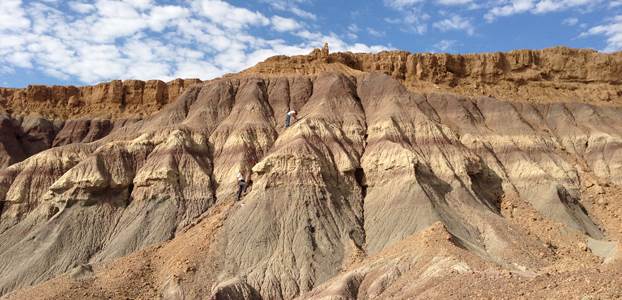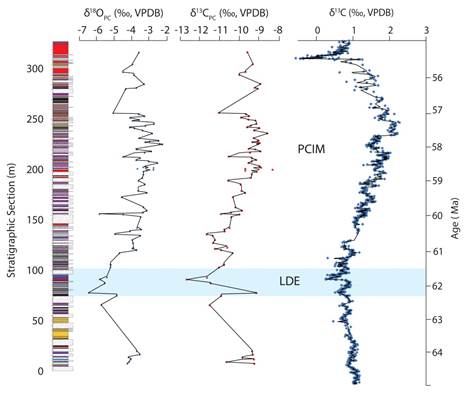58th Annual Report on Research 2013 Under Sponsorship of the ACS Petroleum Research Fund
Reports: ND252222-ND2: Linking Coastal Terrestrial Ecosystems and Eustatic Sea-Level Changes: A Case Study in the Tornillo Group (Big Bend National Park, TX)
Gabriel Bowen, PhD, University of Utah
Our team has made excellent progress toward developing new stratigraphically resolved isotopic, organic geochemical, and lithostratigraphic records documenting Paleocene paleoenvironmental change in Big Bend National Park (BBNP). Our efforts during project year 1 have included:
1) Field work. A team of 4 researchers (the PI, PhD student Clement Bataille, and undergraduates Stephen Ruegg and Alex Lowe) conducted 10 days of field work in BBNP in October, 2012. Our work included scouting localities that preserved long and continuous exposures of the Early Paleogene Black Peaks Formation and describing and sampling a long (350 meter) section through the Black Peaks Fm. Approximately 100 paleosol samples (Fig. 1) were collected for geochemical and petrographic analysis.
Figure 1 – Well developed paleosol profiles in fluvial sedimentary rocks of the lower Black Peaks Fm.
2) Carbonate geochemistry. Undergraduate researcher Ruegg has taken the lead on analysis of the isotopic geochemistry of pedogenic carbonate nodules collected from the BBNP paleosols. His initial work has revealed a strongly structured pattern of carbon and oxygen isotope variation throughout the formation, which we have correlated to pelagic carbonate records (Fig. 2). This correlation, in combination with published paleomagnetic and fossil data, solidifies age constraints for the Black Peaks Fm. and suggest that the BBNP section preserves a near-continuous record of deposition throughout the Paleocene. The record also suggests that the BBCP section may preserve the first terrestrial evidence for an early Paleocene hypothermal event, the Late Danian Excursion (LDE), recognized in marine records. In addition, the strongly coupled long-term oxygen and carbon isotopic variation in our record suggests that the pedogenic carbonate samples preserve a record of regional or global changes in climate and/or hydrological cycling through the Paleocene. This work has been presented at a University of Utah student research exposition, and Ruegg has submitted an abstract and will present our results at the GSA annual meeting this fall. A new graduate student beginning work on the project this fall, Dylana Watford, will conduct carbonate clumped isotope analysis on a subset of the BBNP samples to attempt to provide additional constraints on the paleoclimatic and paleonenvironmental interpretation of this record.
Figure 2 – Lithostratigraphy and carbon isotope stratigraphy of the BBNP Black Peaks Fm. section. PC = paleosol carbonate, PCIM = Paleocene Carbon Isotope Maximum, LDE = Late Danian Excursion. The panel on the right shows the pelagic marine carbon isotope record of Westerhold et al. (2011) from ODP site 1209 in the Pacific Ocean.
3) Organic geochemistry. Undergraduate researcher Alex Lowe and PhD student Clement Bataille have been working to develop methods for organic carbon isotope analysis of the paleosol samples collected in 2012. This has proven challenging because of the relatively low organic carbon content in the rocks and due to the presence of resilient carbonate minerals (including siderite) that interfere with the analysis. Bataille has prepared a manuscript, currently in revision, that will describe some of the challenges associated with the analysis and interpretation of bulk organic carbon isotope measurements in systems such as the Black Peaks Fm. Lowe is beginning work this fall, with collaborators at Utah and the University of Cincinnati, to prepare and analyze lipid extracts to characterize biomarker distributions and stable isotope ratios in these paleosols.
4) Professional development. During the first year of our project we have been able to provide a range of valuable training and advancement opportunities. The supported work has advanced the PI's research portfolio in a new direction, focusing his efforts on Paleocene climate change and carbon cycling. This led to the development of a collaborative proposal submitted to NSF in spring, 2013, focused on elucidating the role of terrestrial carbon storage and burial on the global carbon cycle of the Paleocene and Early Eocene. PhD student Bataille has been engaged in the project in a supervisorial role, and has gained substantial experience mentoring the undergraduates on the project team as they collectively plan and execute field and lab work, interpret data, and prepare presentations and proposals. The two project undergraduates have both been exposed to new field geology and laboratory experience. They are very engaged in the work and have been major players in the research effort from end-to-end. Ruegg will graduate during the coming academic year and is working toward a senior thesis. This past summer he prepared a proposal seeking support to extend his research from the University's Undergraduate Research Opportunities Program (UROP). This proposal was selected for funding and Ruegg was further recognized, among more than 150 applicants campus-wide, by being selected as the 2013-2014 UROP Parent Fund Scholar. Ruegg and Bataille will both present components of our work at the fall 2013 GSA meeting.
Copyright © 2014 American Chemical Society













